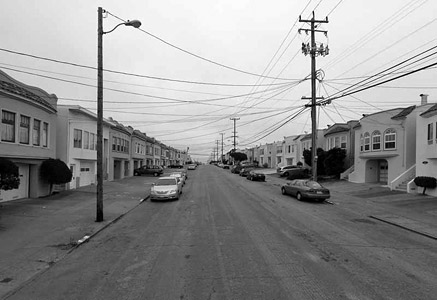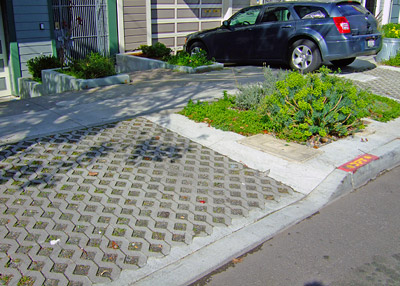Driveways allow necessary access across the sidewalk to residential and commercial garages. Too many driveways are a negative presence in the pedestrian environment, as they present potential conflicts between drivers and pedestrians and increased possibility that pedestrian through travel will be compromised.
In many areas, the high number of driveways and width of driveway curb cuts reduces the available space for planting and other amenities. Improved driveway design can provide added space for planting to improve street aesthetics.
Design Guidelines
Driveways should be designed to minimize impact on through travel or pedestrian use of the sidewalk.
Driveway curb cuts for individual residential properties should not be wider than 7 feet with 1 1/2 foot wings (10 feet total width). Where truck loading is the dominant activity, they should not be wider than 8 feet with 1 1/2 foot wings (11 feet total).
Driveway curb cuts for two-way traffic should not be wider than 18 feet. An exception should be made on industrial streets in locations requiring frequent access for large trucks or semi-tractor trailers, where two-way driveway curb cuts may be up to 24 feet in width.
DPW standard plans for driveways should be consulted for engineering standards for driveway construction.
Curb cuts are discouraged in pedestrian-intensive areas. Reducing driveways reduces the number of conflict points between pedestrians and vehicles and can dramatically improve safety.1
Wherever possible, commercial, industrial, and large residential properties should consolidate driveways by interconnecting parking lot and loading area entries and by sharing parking among uses.
In areas of San Francisco where alleys provide access to the rear of properties, curb cuts onto streets are strongly discouraged; all parking and service access should be provided via the alley.
On new streets, alleys should be provided, minimizing the need for new driveway cuts on primary streets.
Because driveways handle relatively low volumes of traffic, alternative surfacing materials including unit pavers and other permeable materials may be installed in driveways where frequent heavy trucks are not expected to cross over.
The clear throughway zone of the sidewalk should be a continuous material.
Driveways may be bounded by permeable paving, curb extensions or landscaping areas that extend from the sidewalk into the parking lane, eliminating the need for driveway aprons.
 |
Parking-lane planters can be located between driveways where space is too narrow to allow a vehicle to park. Where planters extend into the sidewalk furnishings zone, they can be designed to occupy the space of driveway wings, narrowing the driveway and widening the planting area. |
Notes:
1.Source: http://www.ctre.iastate.edu/research/access/toolkit/3.pdf. See also pages 11-13 of the following document: www.ctre.iastate.edu/PUBS/tsinfo/ts1-6.doc







 Copyright © 2015
Copyright © 2015